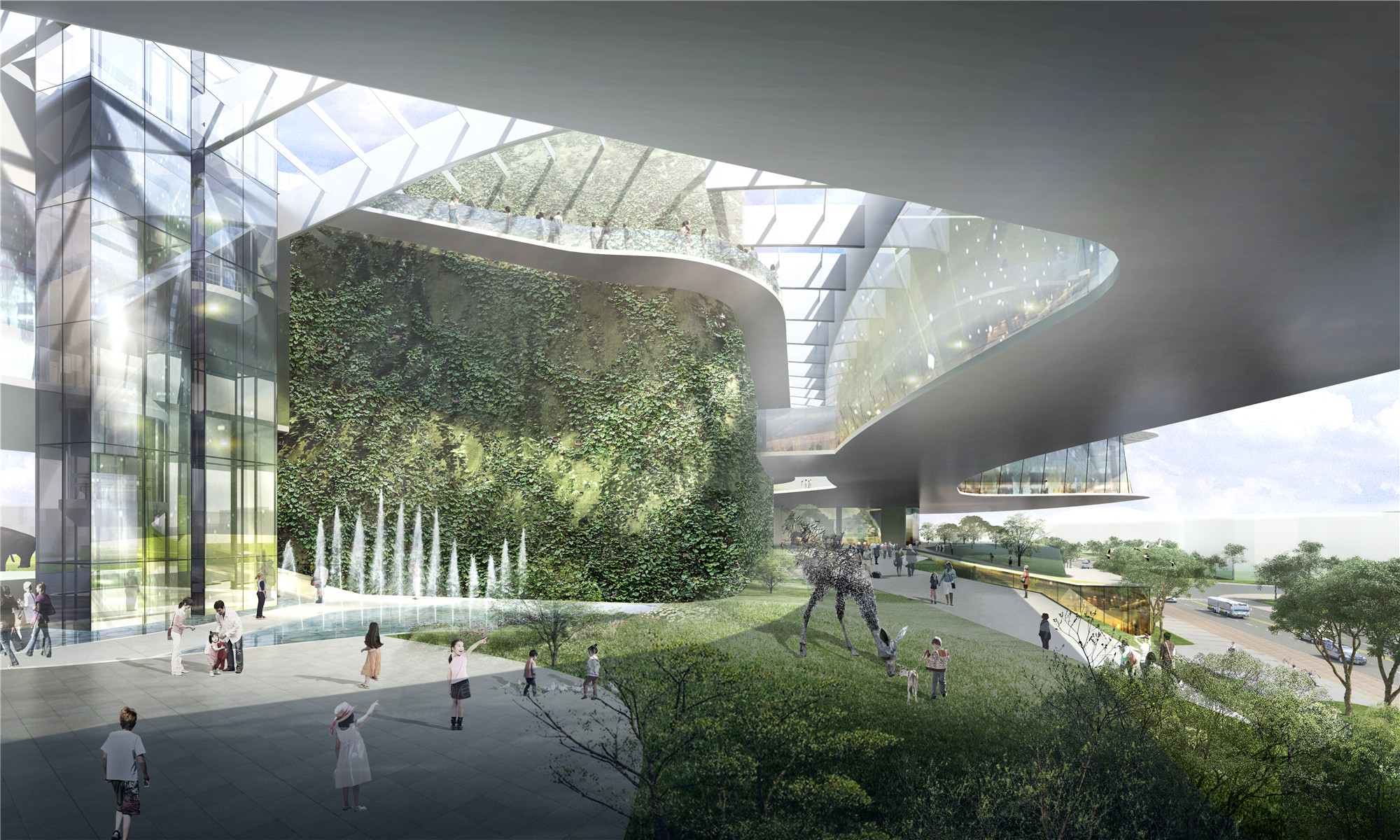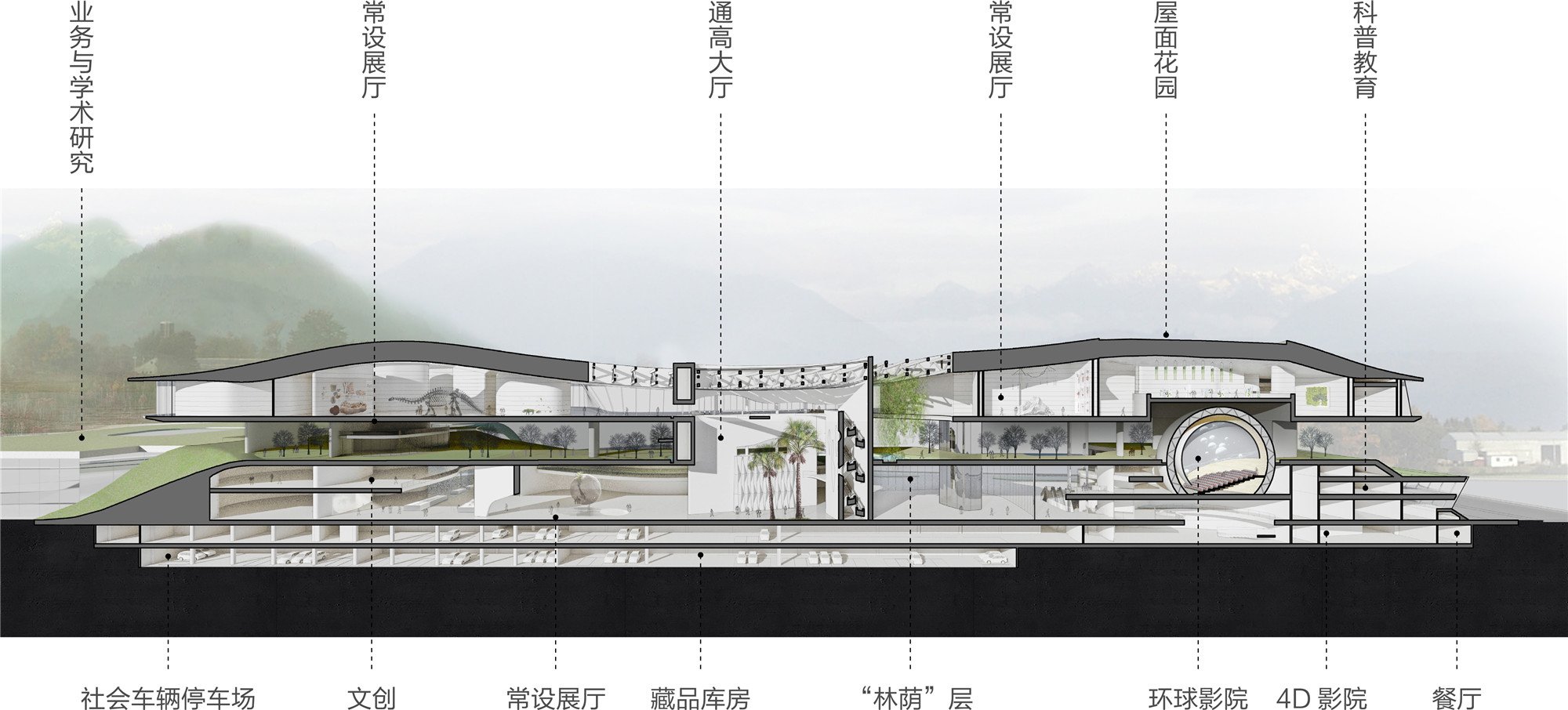
设计单位 筑境设计+欧博设计
方案状态 中标候选方案
项目地点 广东省深圳市
总建筑面积 103637平方米
城市边,山水旁,一片自然资源优厚的土地,未来的深圳自然博物馆将坐落于此。带着对自然的敬畏与尊重,带着对人与自然关系的愿想,设计也将从这里开始。
Beside the city, by the landscape, it is a piece of land with rich and profound natural resources. The future Shenzhen Natural History Museum will be located here. With awe and respect for nature, having the desire to think about the relationship between human and nature, the design proposal will also start from this point.
▲ 视频介绍 ©筑境设计
突显自然,融入自然
营造山水边一片充满生机的“林地”
By emphasizing nature and blending into the nature, this proposal creates a vibrant forest land by the landscape.
设计试图消解建筑在面对山水时的体量感,以轻盈的方式介入场地。布局在充分考虑博物馆主入口和建筑与东侧广场关系的同时,特将博物馆面向燕子岭呈怀抱状展开,并通过几组结构的支撑体,构成建筑底部与空中两大部分,以使北部的自然山水最大限度地延伸入中部开放空间,渗透入城市,使博物馆与自然融为一体,宛如山水边的一片林地,散发出自然的气息。
The design proposal attempts to eliminate the volume of the building facing the landscape and to intervene in the site gradually and lightly. With a fully consideration of the relationship between the main entrance of building and a square to the east side, the museum is openned as much as possible to the YanZiLing mountain, as hugged by the landscape. And through several groups of the supporting structure, there creates two main parts of the building—the bottom part and the part in the air, so that the natural landscape to the north could become an extension of the central open space and penetration into the city. Thus, the museum and natural landscape are harmoniously and organically integrated together as a whole. The museum is like a piece of landscape on the edge of land, continuing the natural breath.



以公共、开放、多层次的空间形式
营造富有生机与活力的场所
By creating open, public and multi-level forms of space, this proposal brings a place full of activity and vitality.
中部“林荫”层和屋面花园层是博物馆的开放层。“林荫”层如同丘陵地带的一片绿荫地,接城市,连山水,契合了深圳的气候特点,成为博物馆富有吸引力的户外开放展览场所,人们可在此交往、休憩、感受自然。屋面花园层空间舒朗、视野开阔,可通过室外垂直电梯或坡道直达,是人们活动、露营、欣赏自然山水的佳好场所。两个层面相互关联,并与博物馆主体展览空间交织互动,丰富了观展活动的内容与体验。
The green floor in the middle level and the roof garden floor are two open levels of the museum. Like a shady place in a hilly area, the green floor is a connection between the city and the mountains, They fit the climate characteristics of Shenzhen and become attractive outdoor exhibition venues for museums,where visitors could communicate, relax and enjoy the natural atmosphere all at once. The space of roof garden floor is comfortable, with broad vision, and is directly accessible for visitors through the outdoor vertical elevator or ramp. It is a good place for activities, and appreciating the natural landscape. The two levels are interrelated and interwoven with the main exhibition space of the museum, which enriches the content of the exhibition activities, and deepen the experience of visiting.




提供丰富的支持性场所
创建“不落幕的自然博物馆”
By providing a series of all-time open places as supports, to create ‘a museum of nature which will never close.
博物馆的专题展览功能位于底层和上部,它们通过中部通高中庭的垂直交通便捷相连,为参观者提供了不同层面、不同氛围的观展体验,使参观者不仅能在展厅中认识自然,也能在眼前真山水的呈现中更深切地感知、珍爱自然。此外,利用中部“林荫”层和屋面花园层的组织,也为博物馆各部分功能提供了各时段皆能够激发活力的场所支持,真正使自然博物馆在融入自然的同时,也融入城市生活,成为“不落幕的自然博物馆”。
The thematic exhibition space is placed on the ground floor and the upper part of the museum, which is connected closely by the vertical traffic void space in the middle of the museum. Different levels of space brings different kinds of atmospheres for the visitors to be embodied into the natural world both through exhibition halls and real natural scenery. The green level in the middle and the roof garden also makes it possible for citizens to enter the museum at any time of the day, which energize the place itself. Thus, integrated into the nature, and also the urban life simultaneously, the museum becomes ‘a museum of nature that will never close.




以轻盈、空灵的建筑及结构形式创造空间
呈现山水与人文风景
Using light structure to create ethereal space, presenting landscape and cultural backgrounds.
博物馆建筑造型采用非几何状的有机形式,简洁流畅,结构合理并富有特色,设计采用多组筒体结构来支撑顶部空间桁架,以此吊挂上部展览层,并以自由流动的建筑形态来融入山水环境的场所气象,使建筑轻盈、通透。这样的形式不仅大大降低了如此规模的建筑可能对周围环境形成的阻隔感与压迫感,也因此提供了“城市·人·自然”交融互动的开放空间,它们有如山水边一片生机盎然的林地,又宛如一片漂浮在城市与山水间的如意祥云,真正契合了自然博物馆所应具有的精神气质。
The architectural modeling of the museum adopts non-geometric organic forms, which are simple and smooth, with reasonable structure and full of characteristics. It adopts multiple tube structures to support the space truss at the top of the museum, so as to hang the exhibition space at the top part. Moreover, the free-flowing architectural form blends into the natural atmosphere of the site environment to make the building light and transparent. Such a form not only greatly reduces the negative influences of a large volume such as a sense of isolation and oppression to the surrounding environment, but also provides an open space of integration and interaction among city, human and nature, they are like a vibrant woodland by the mountains and rivers, and like a cloud of auspicious clouds floating between the city and the mountains and rivers, which truly conforms to the spiritual temperament that a natural museum should have.


在深圳自然博物馆方案及建筑专业初步设计国际招标中,杭州中联筑境建筑设计有限公司+深圳市欧博工程设计顾问有限公司、贝加艾奇(上海)建筑设计咨询有限公司+3XN A/S+筑博设计股份有限公司、株式会社藤本壮介建築設計事務所+香港华艺设计顾问(深圳)有限公司共同成为中标候选方案的设计团队,最终贝加艾奇(上海)建筑设计咨询有限公司+3XN A/S+筑博设计股份有限公司赢得此次竞标。
设计图纸 ▽






完整项目信息
项目名称:深圳自然博物馆
项目地点:广东省深圳市坪山区
用地面积:42007平方米
总建筑面积:103637平方米
主创建筑师:王幼芬
设计团队主要成员:骆晓怡、祝狄烽、宋子雨 、周盛遥、岳凯、江丽华、徐宇城、官恩平、陈立国、胡泊、金玉泽、韦舒懿、谢家豪、姚嘉薇
设计单位:杭州中联筑境建筑设计有限公司+深圳市欧博工程设计顾问有限公司
版权声明:本文由杭州中联筑境建筑设计有限公司授权发布。欢迎转发,禁止以有方编辑版本转载。
投稿邮箱:media@archiposition.com
上一篇:戏剧之城-新潞运河创意区 / 普罗建筑 officePROJECT
下一篇:蘑菇木屋:松林中的架空体量 / ZJJZ 休耕建筑